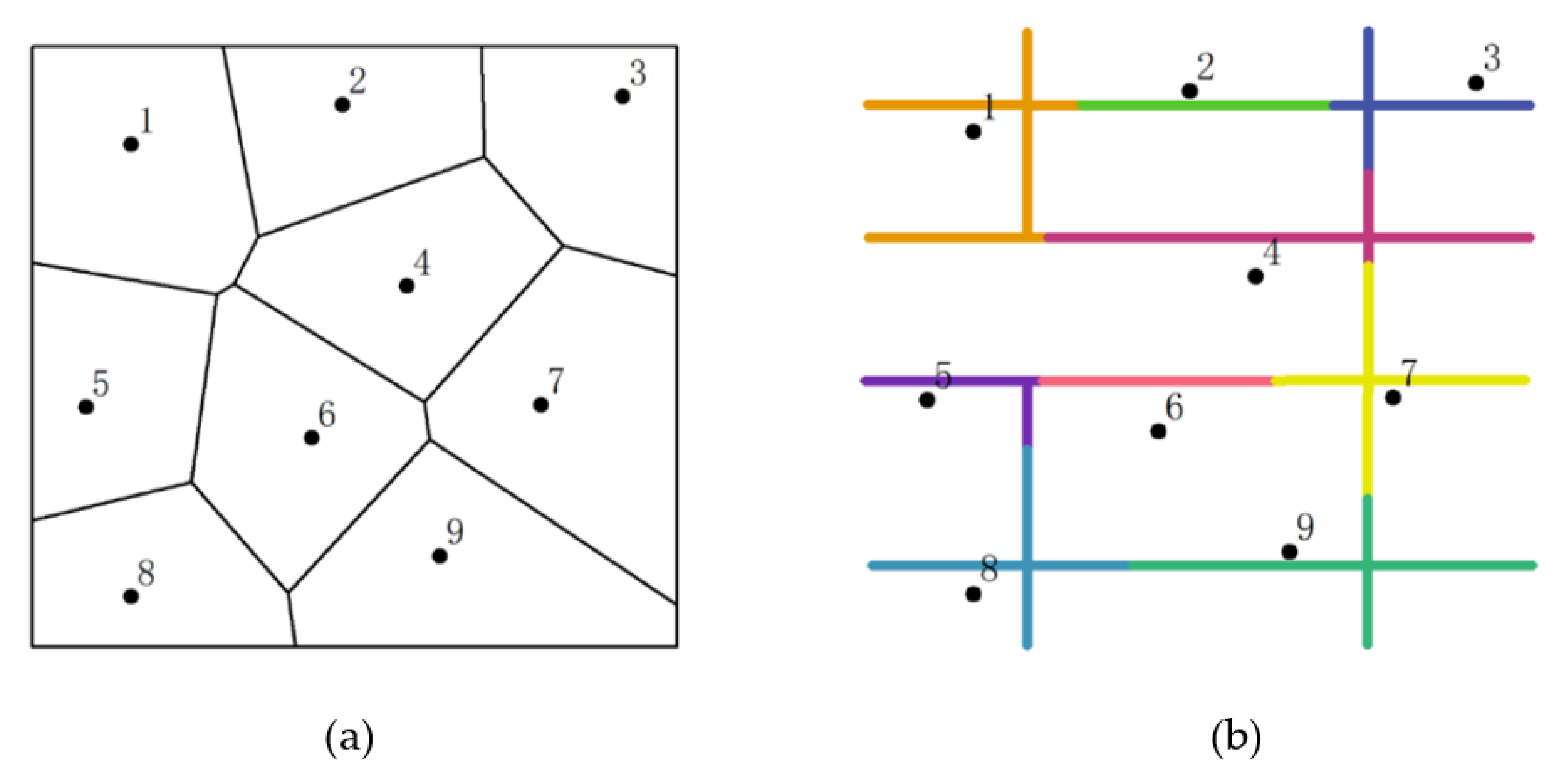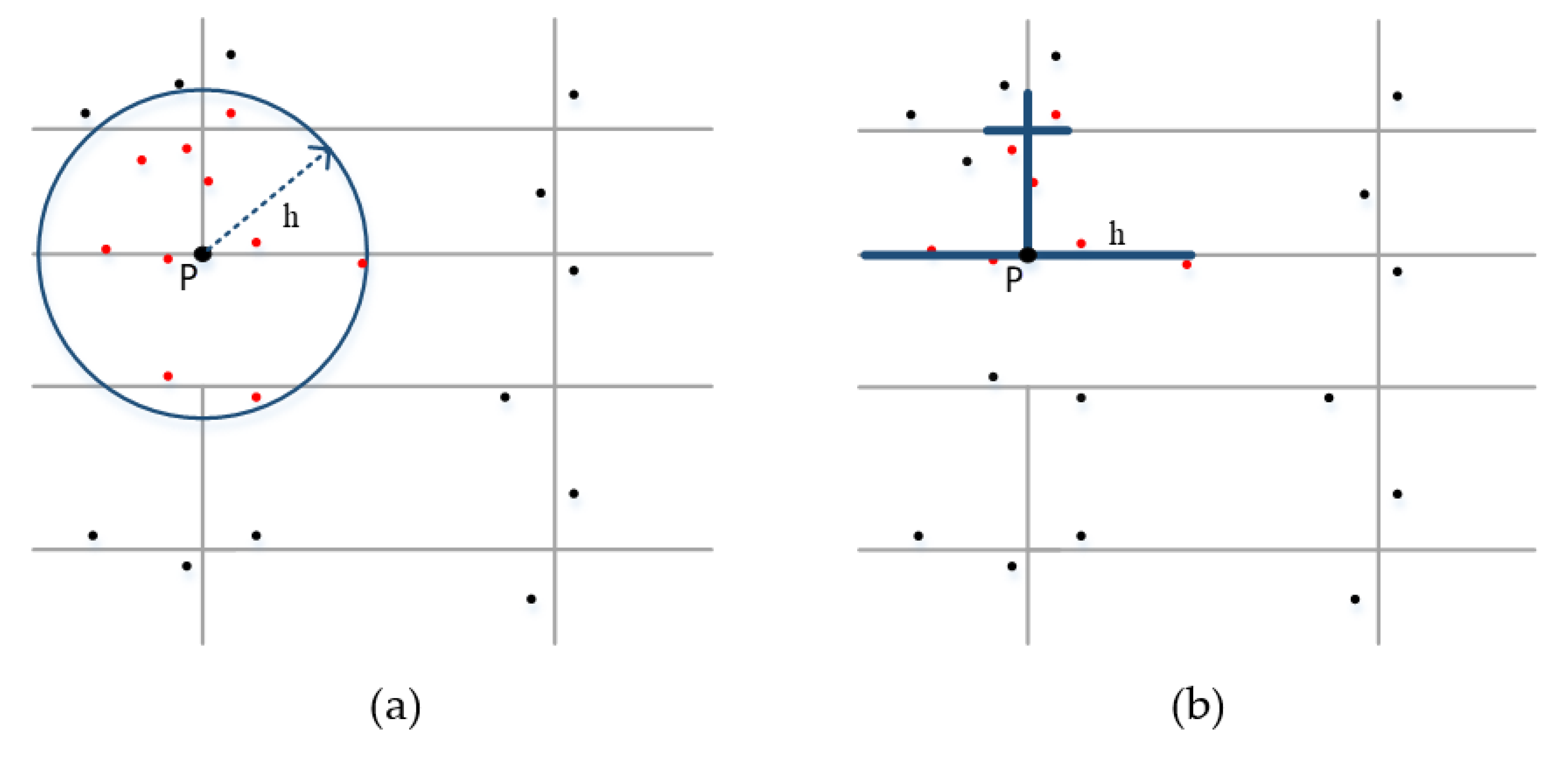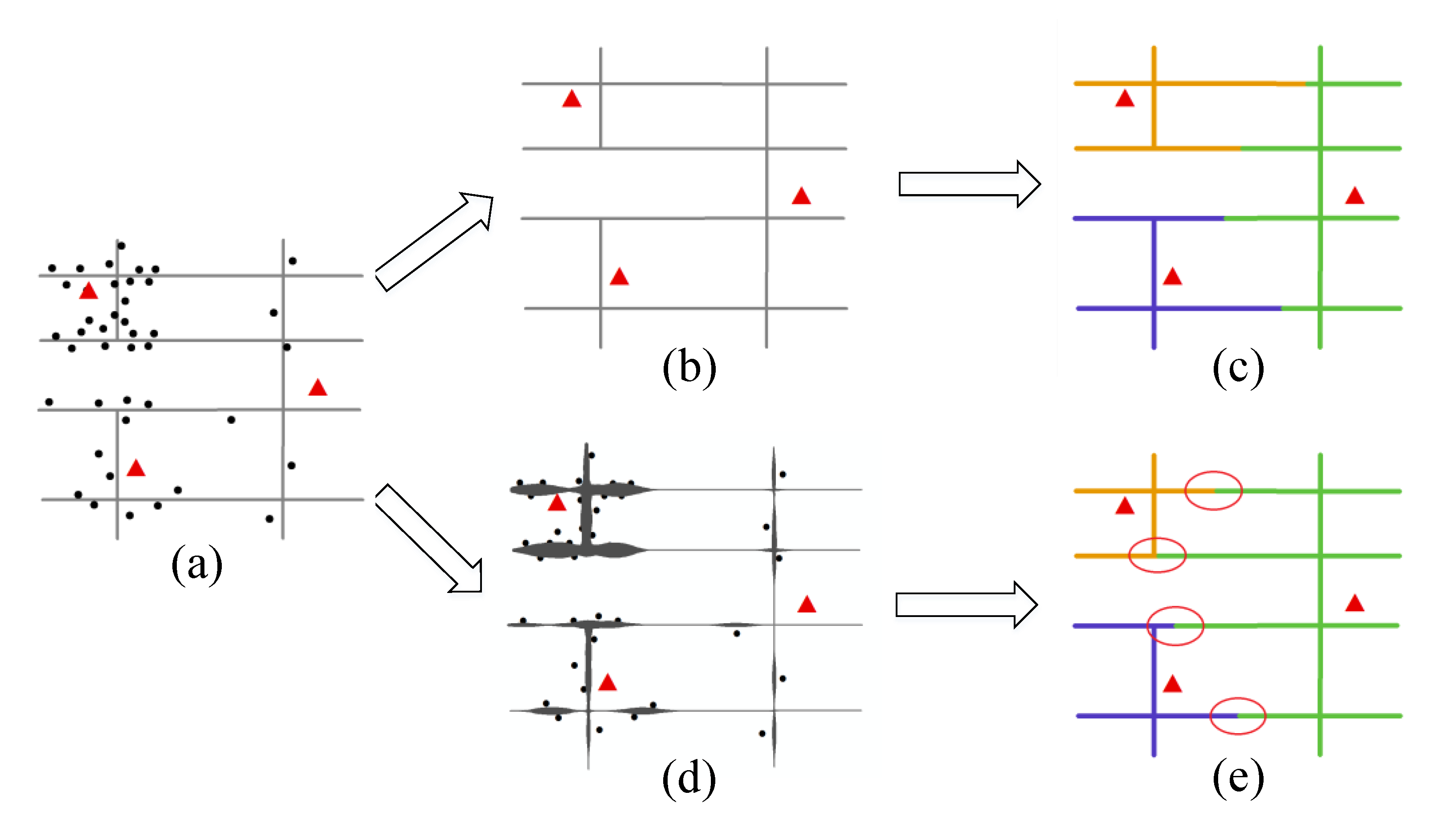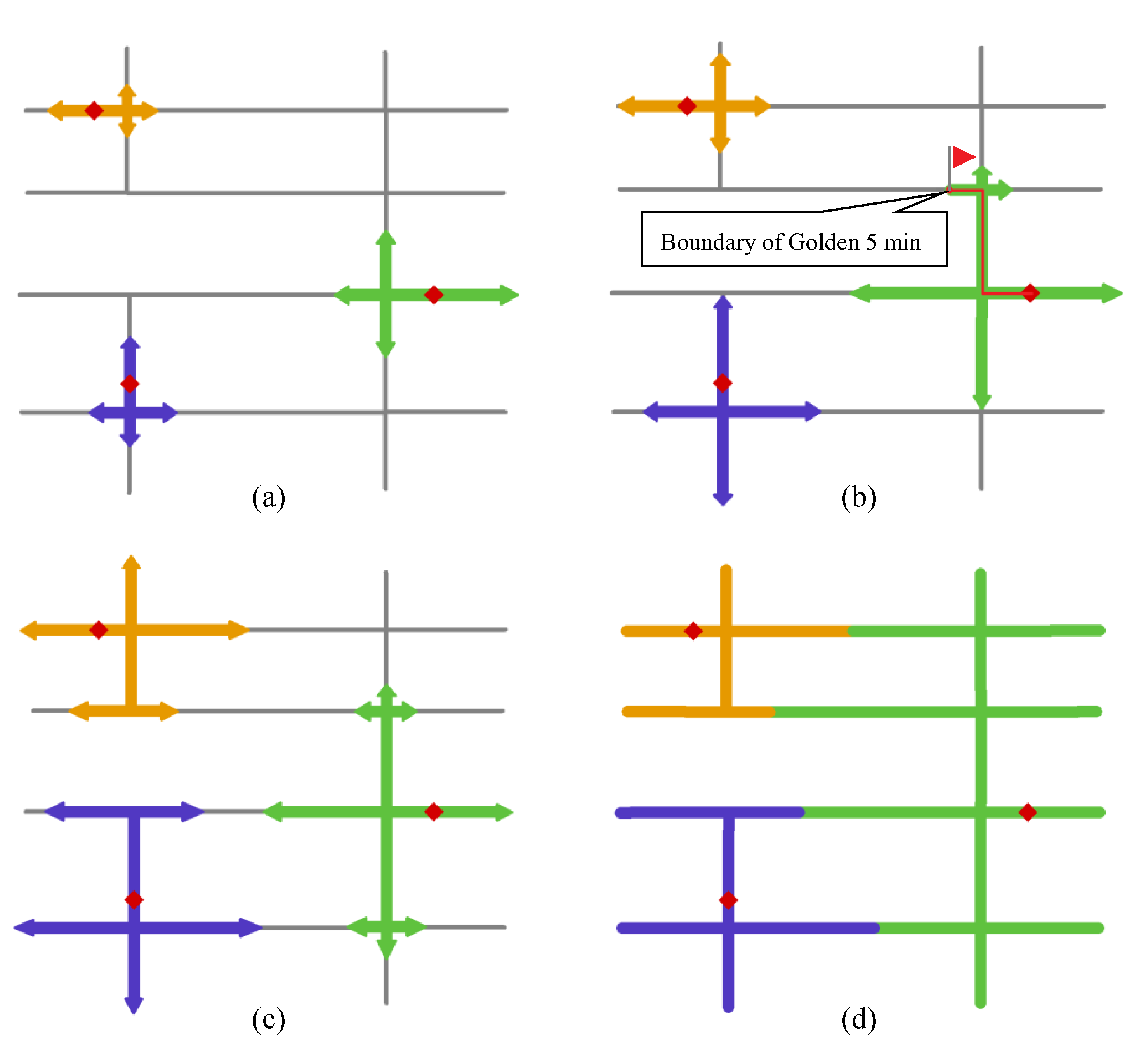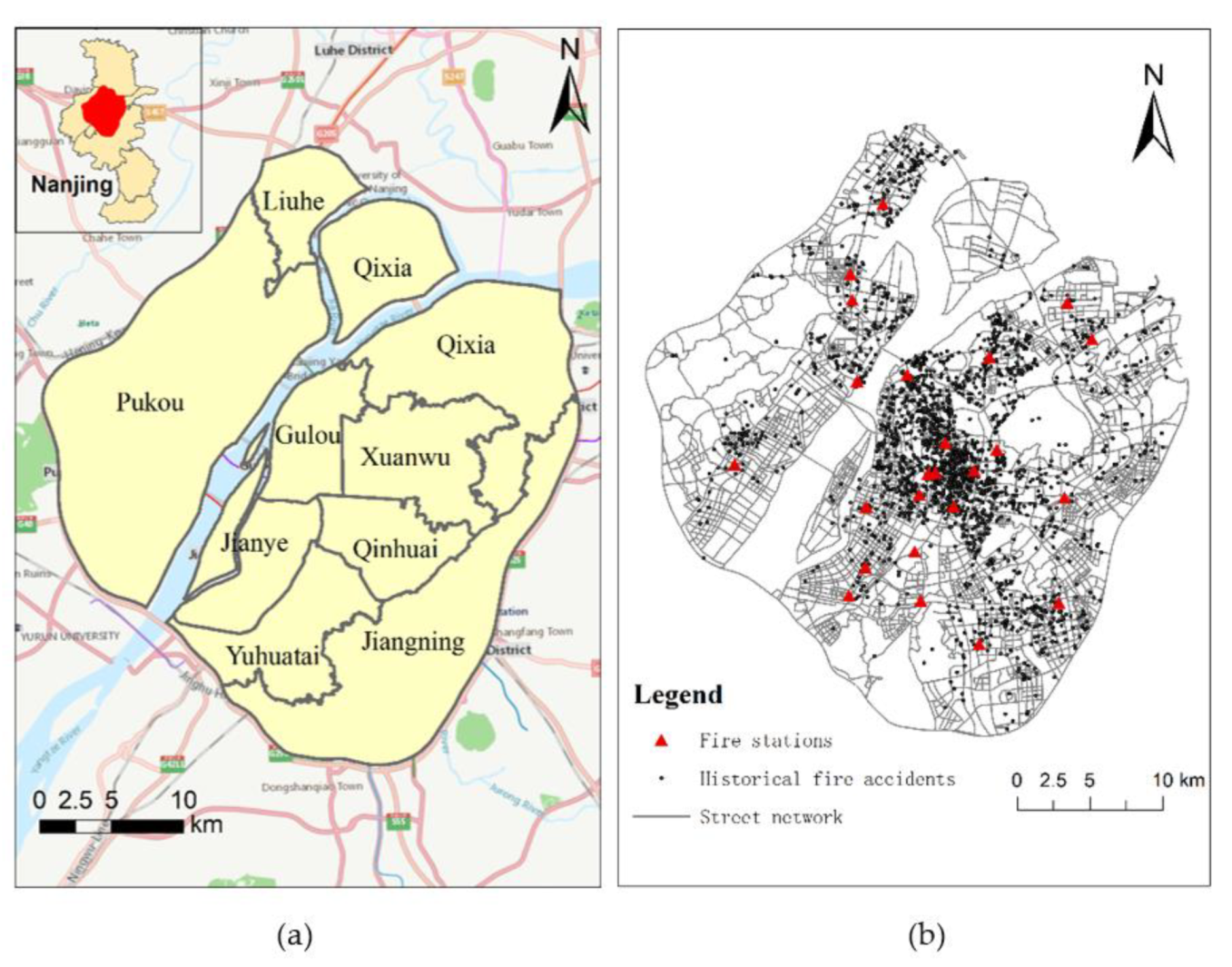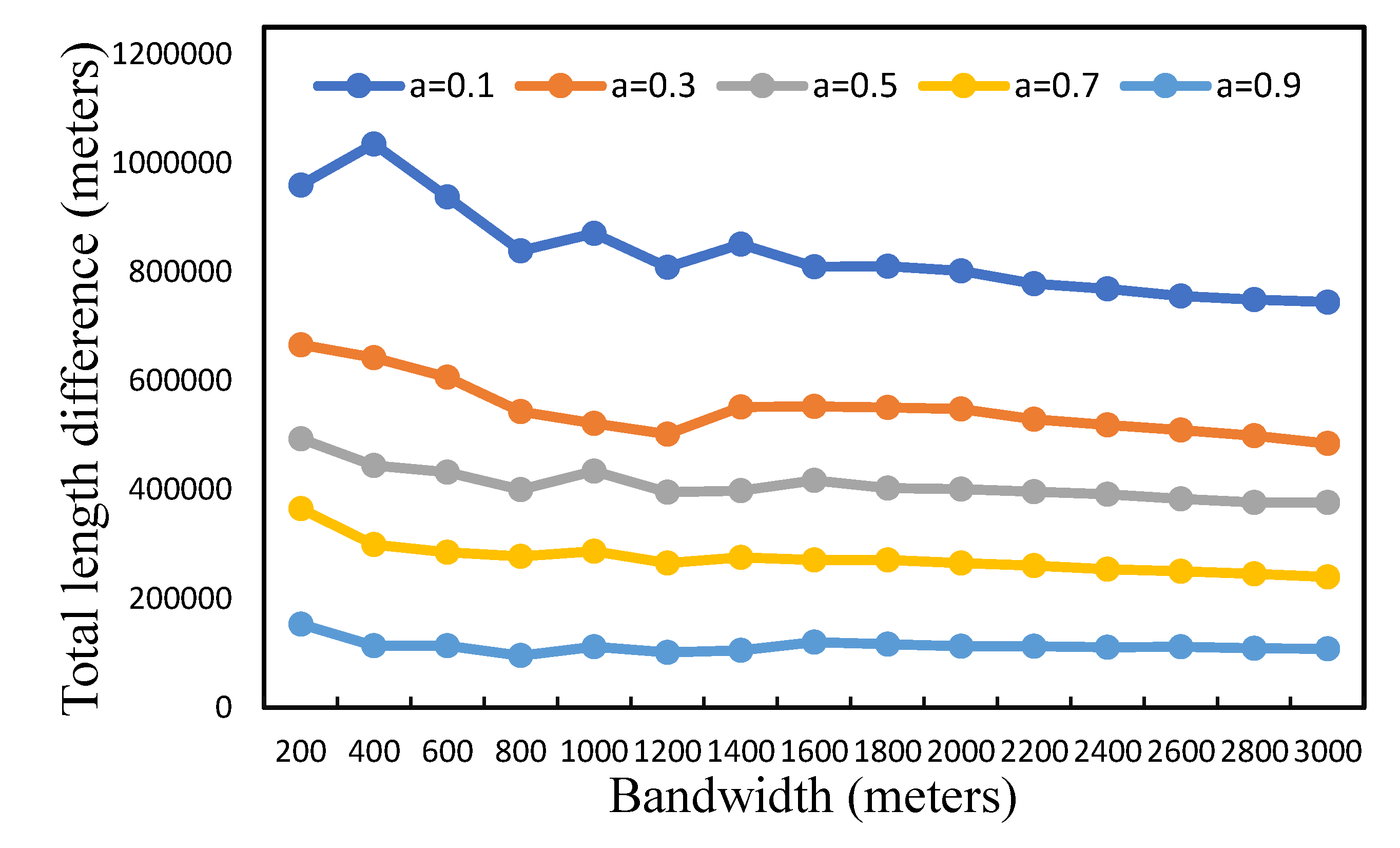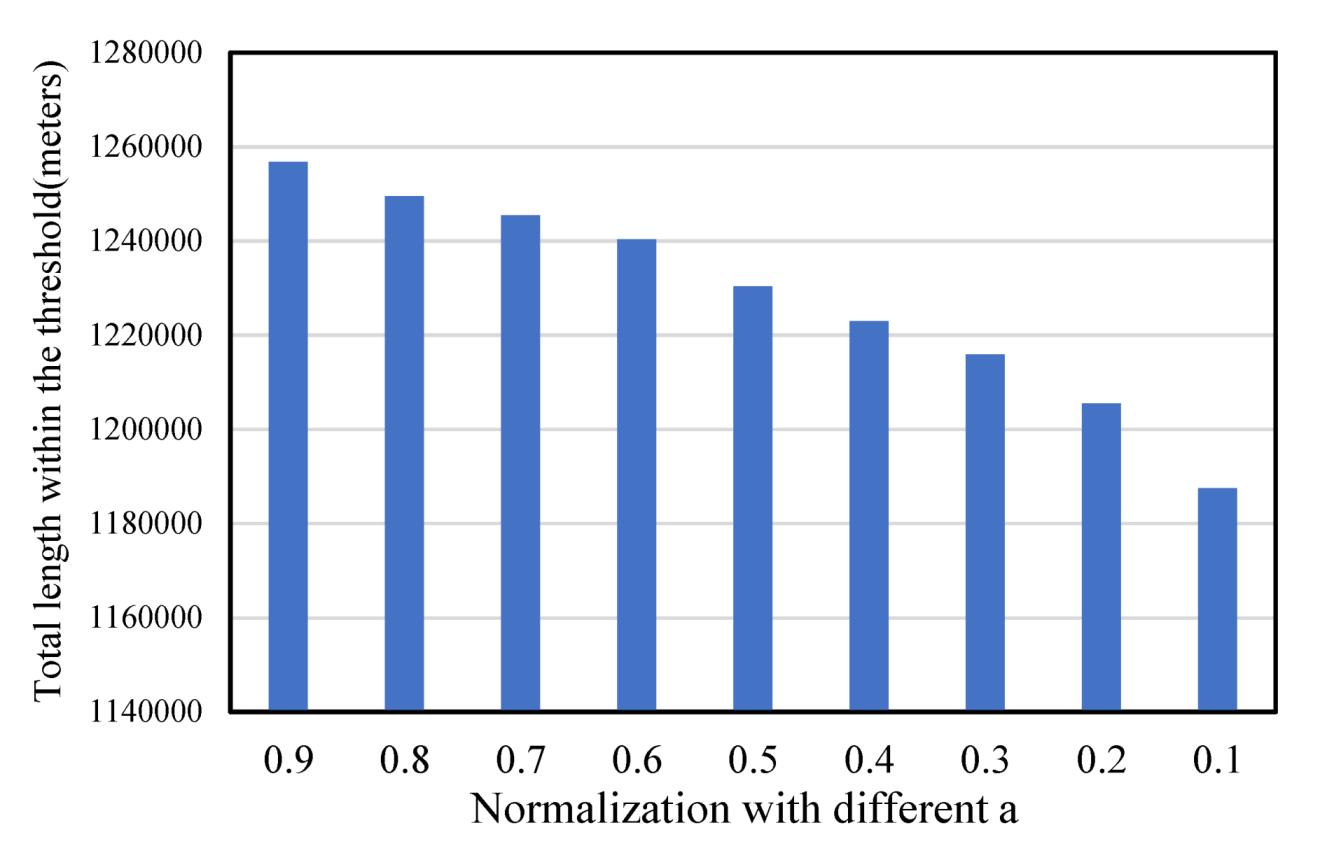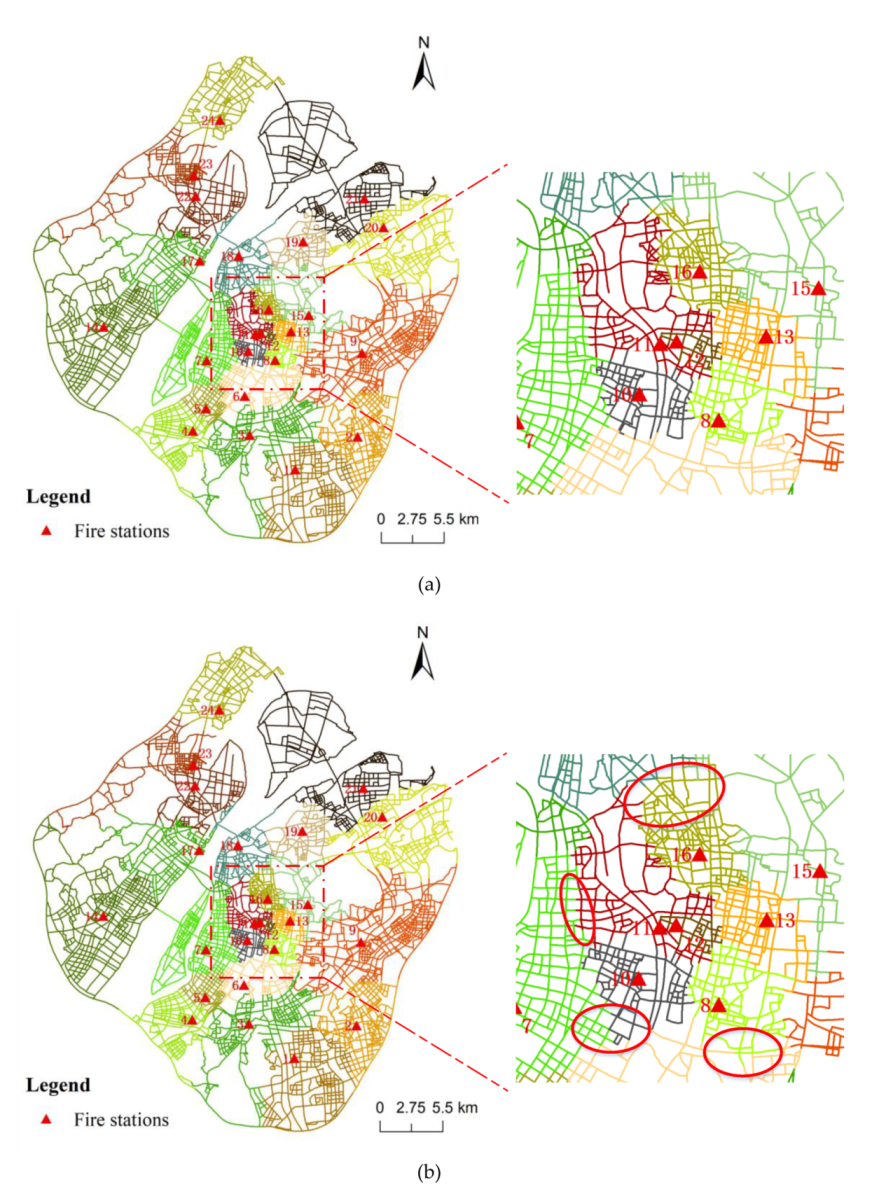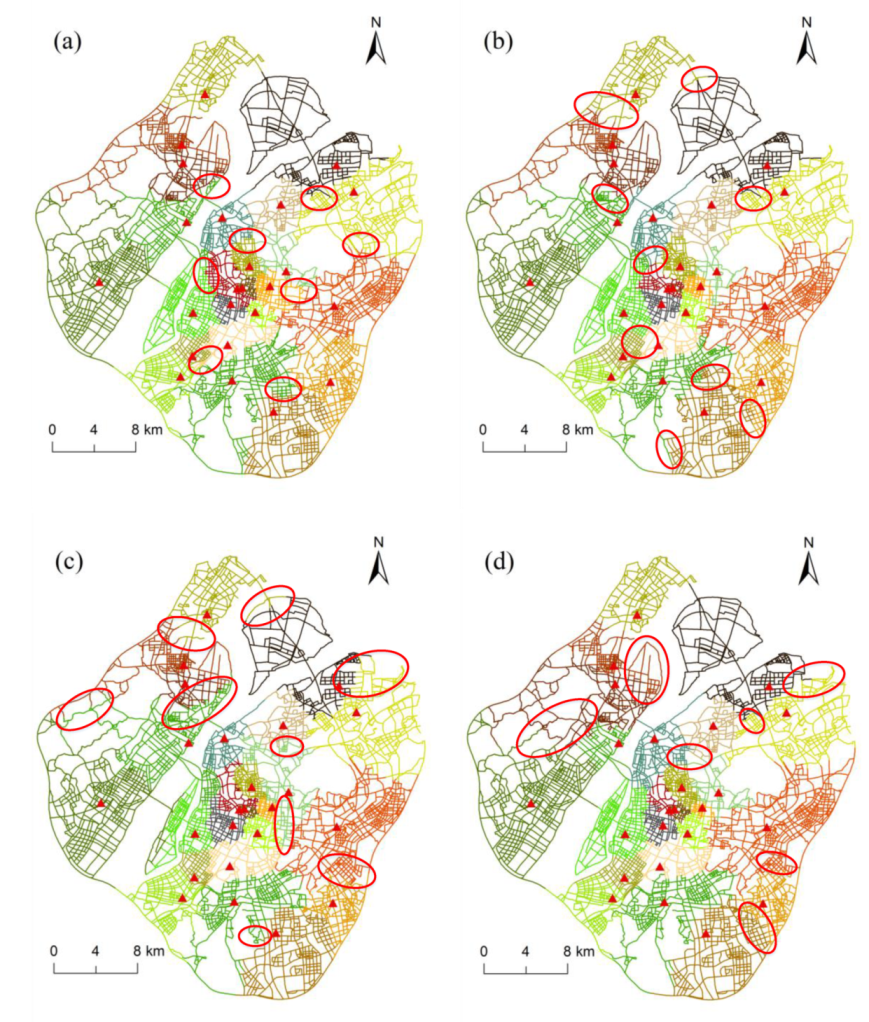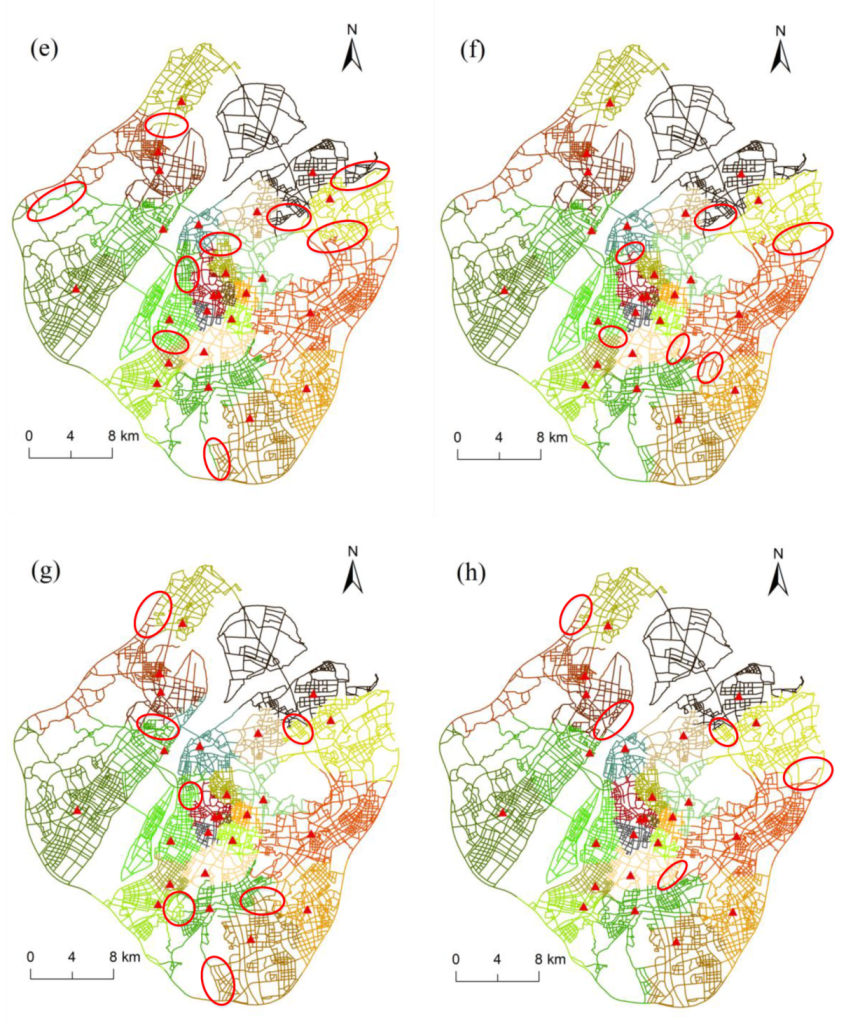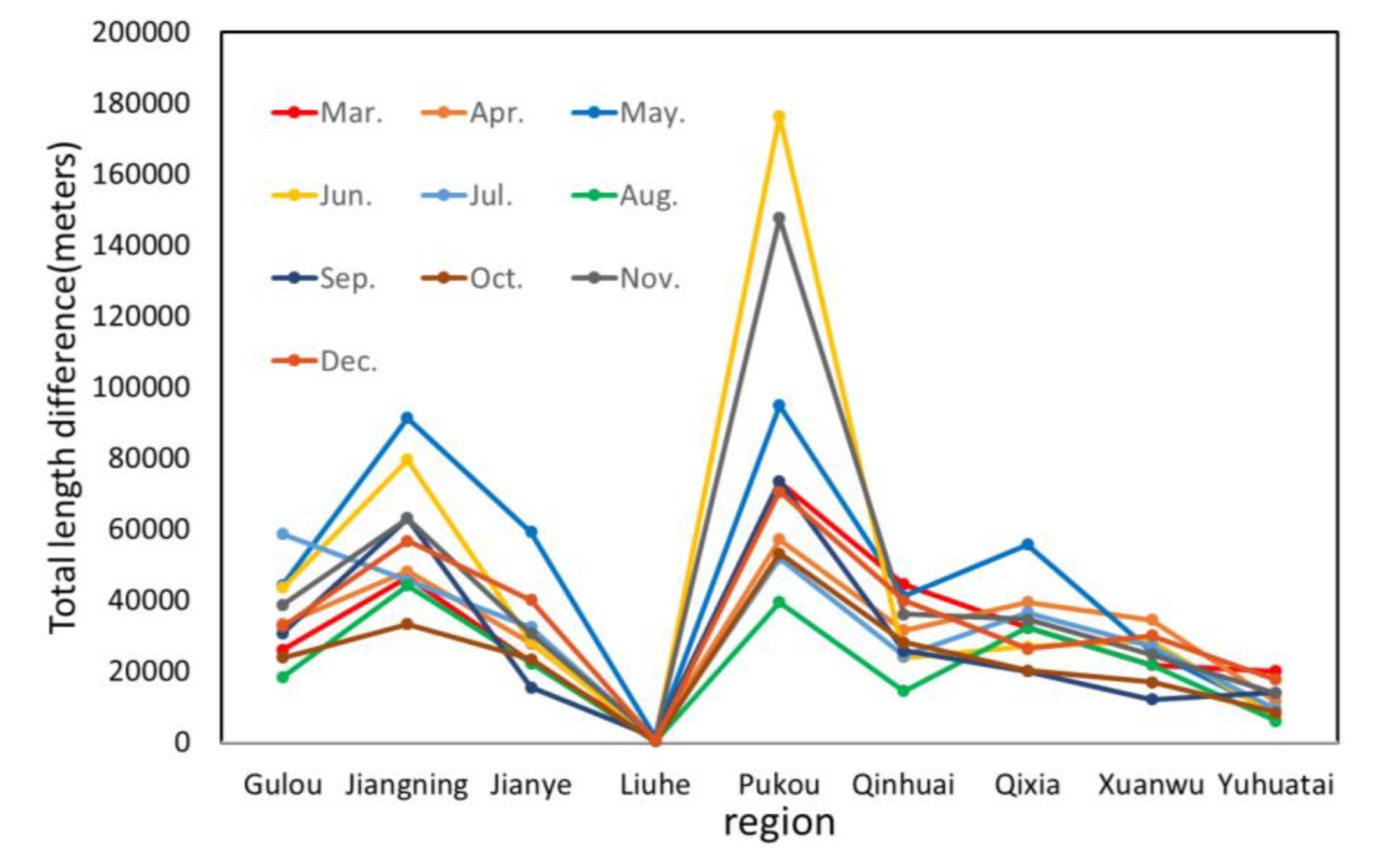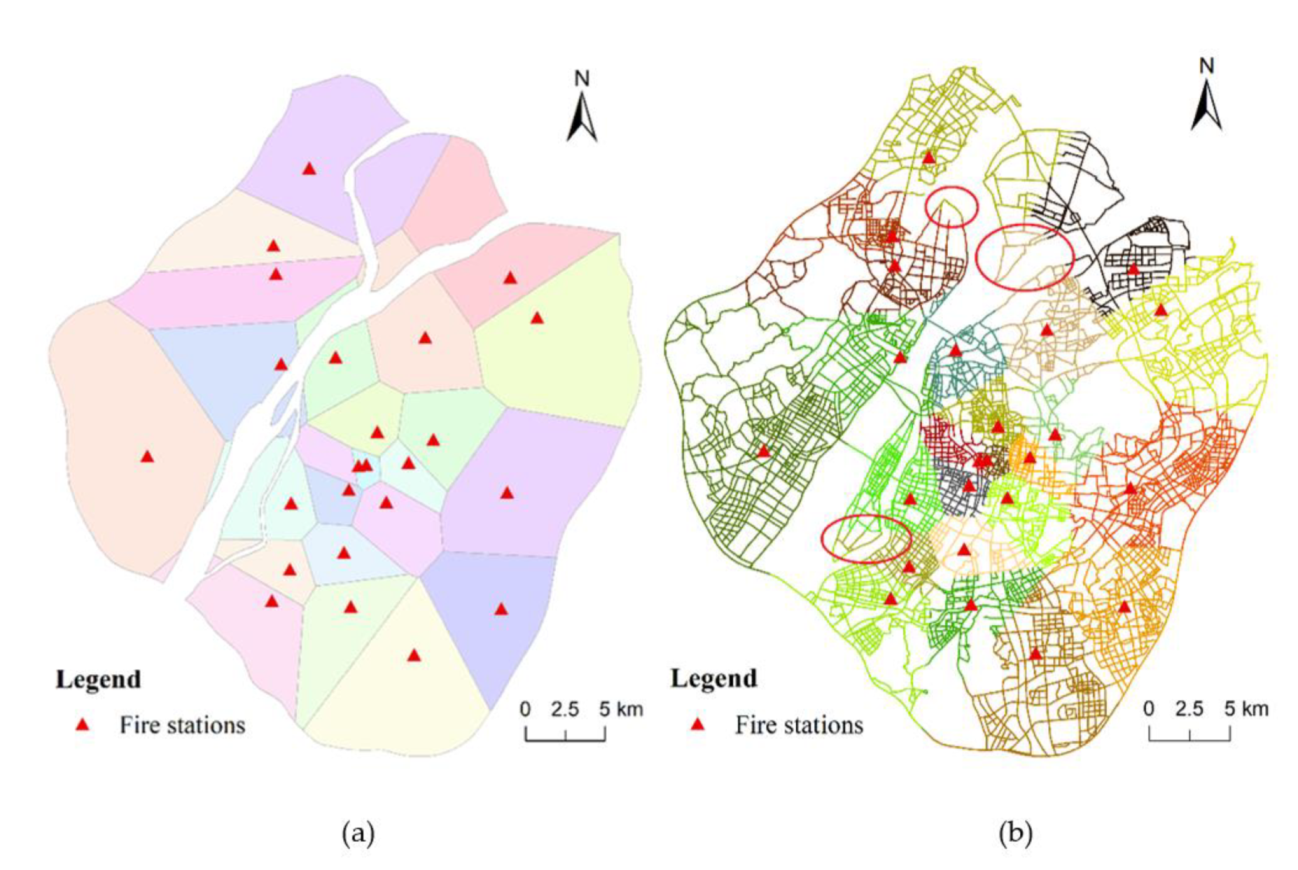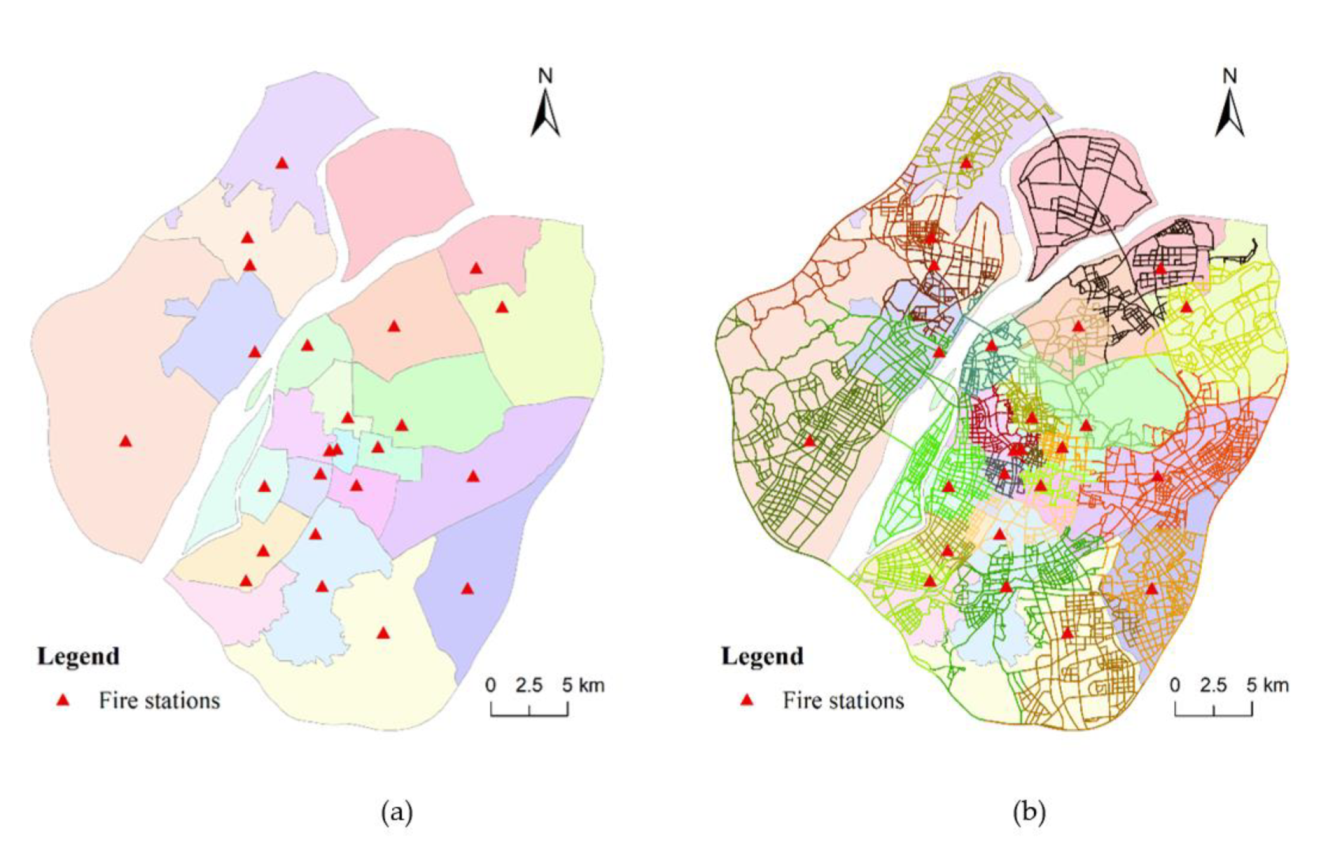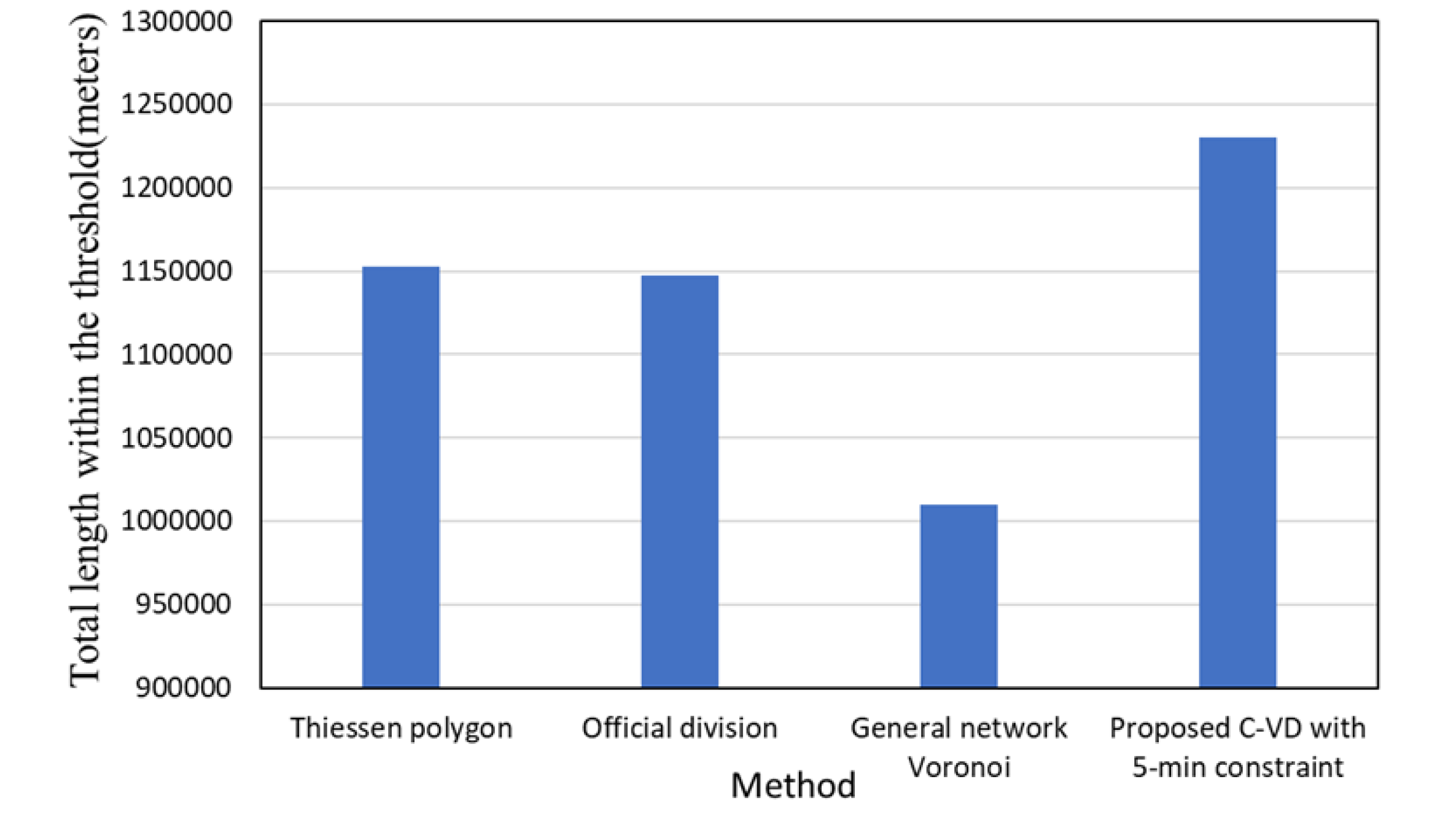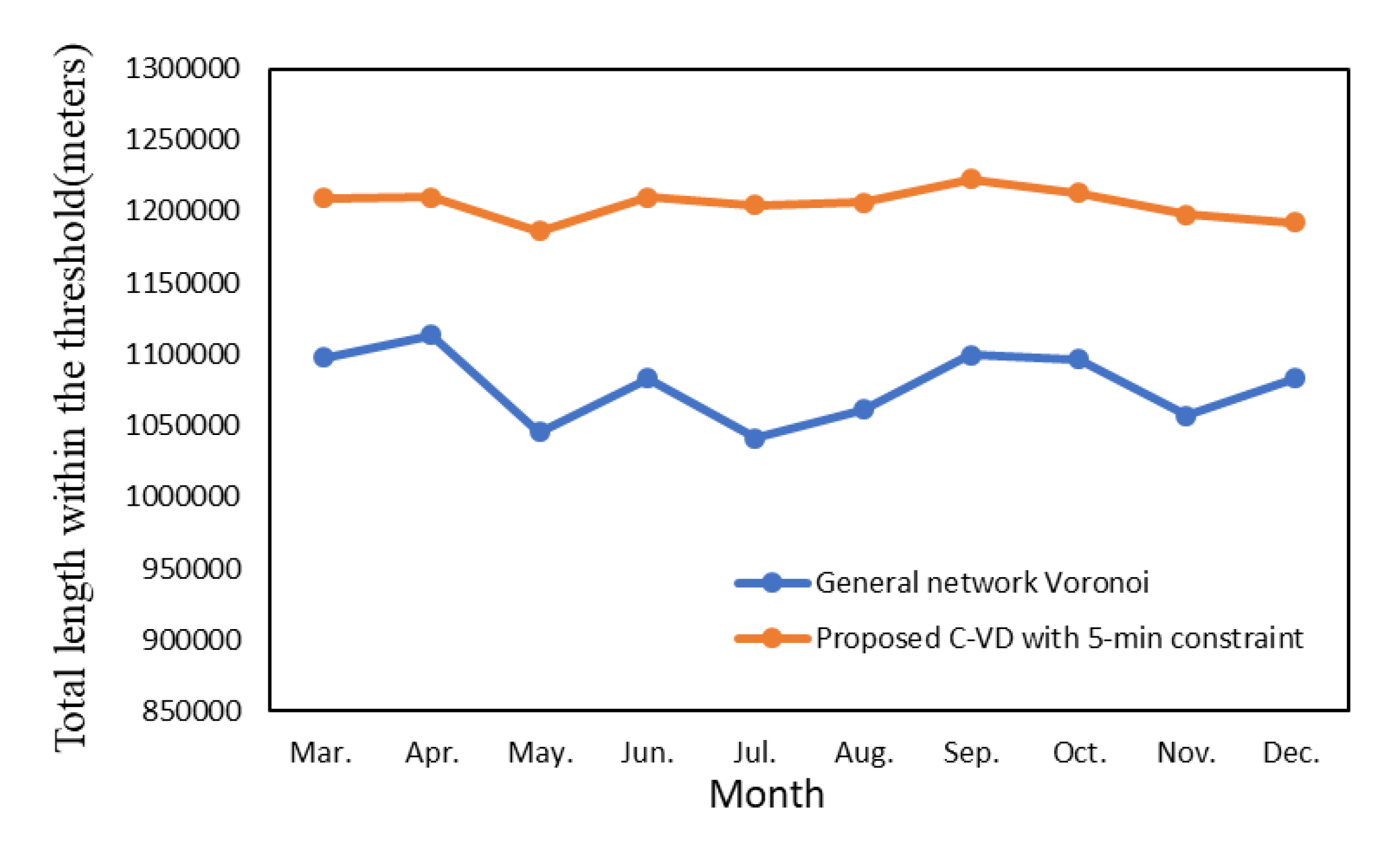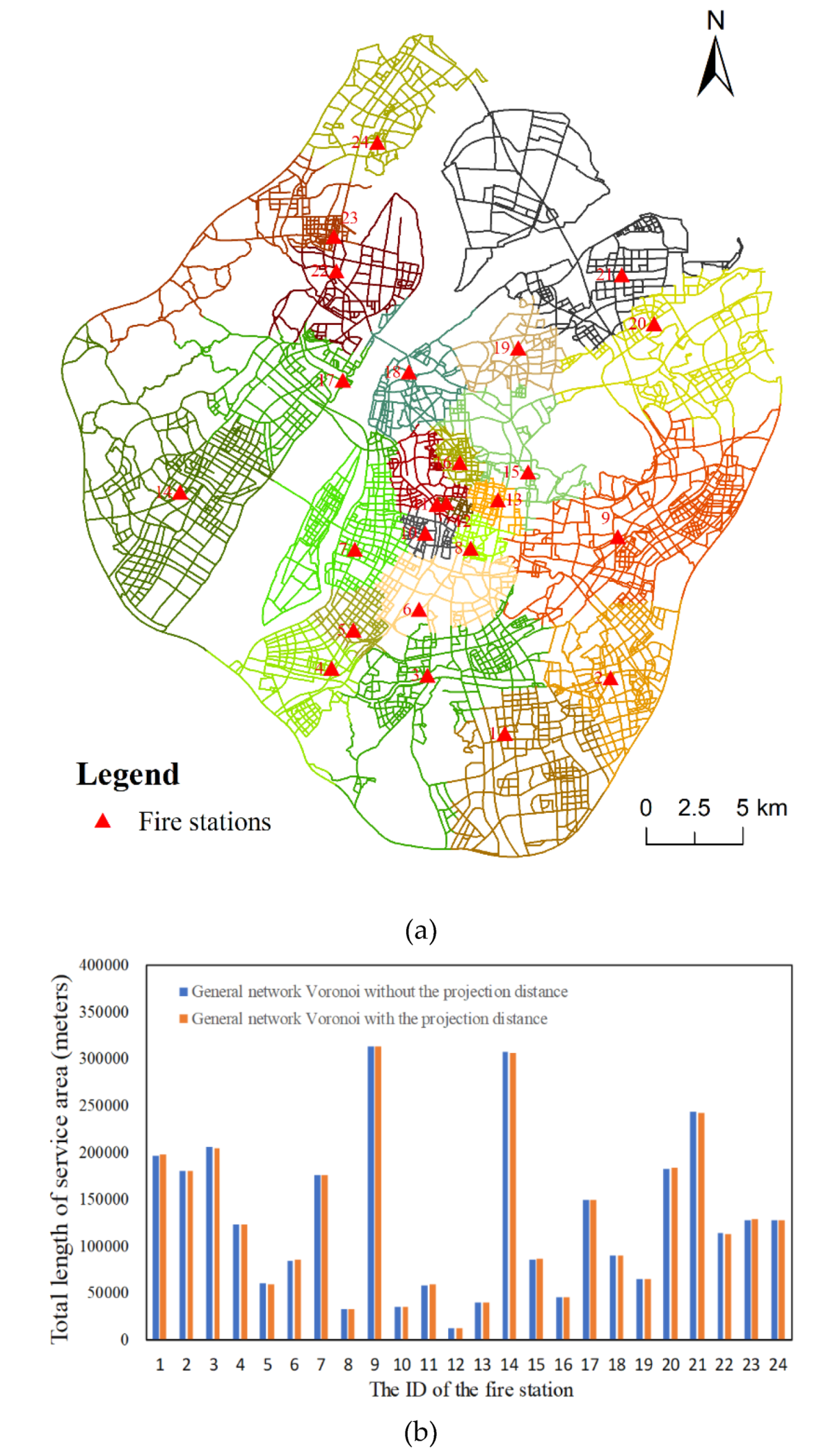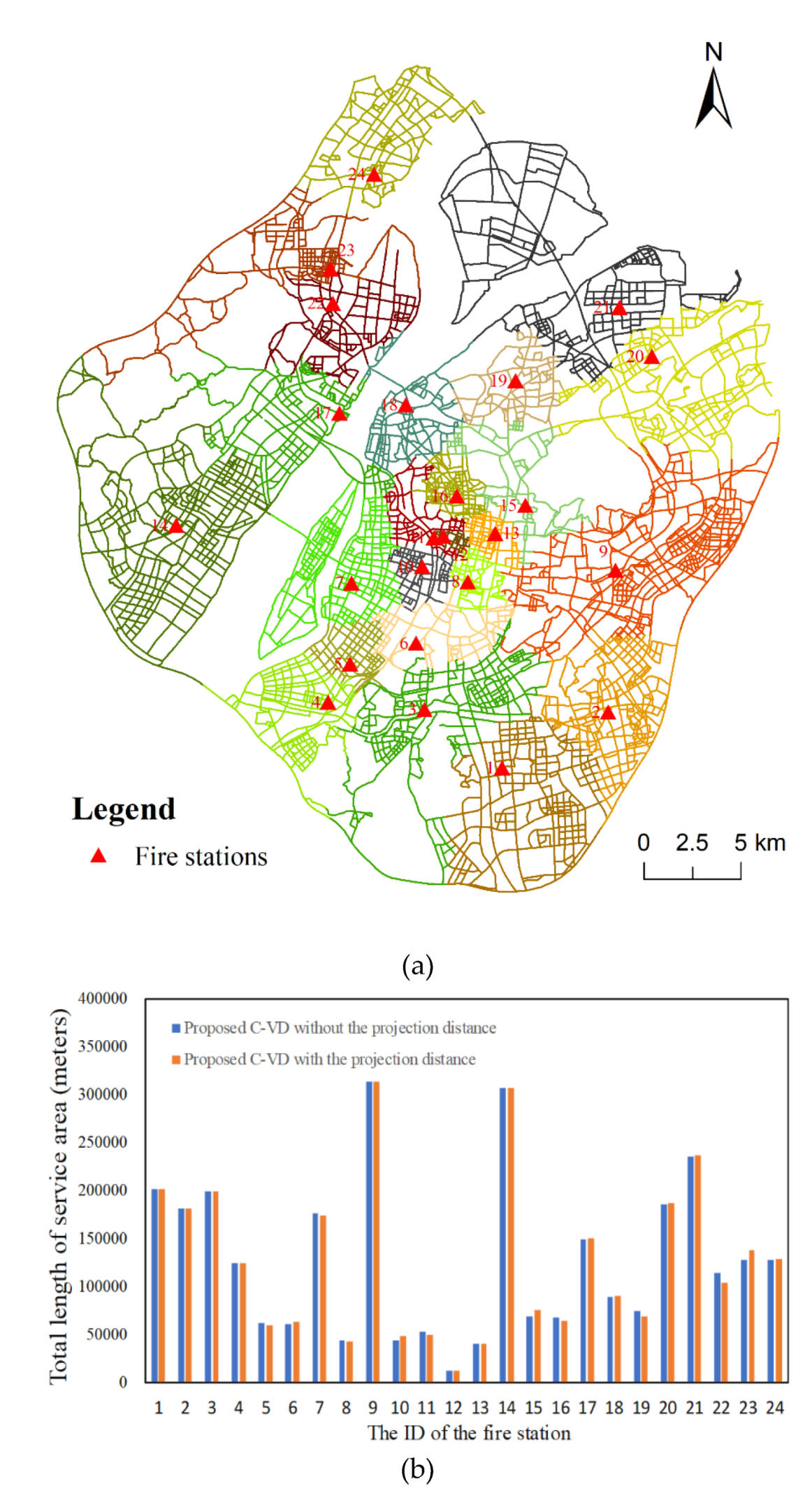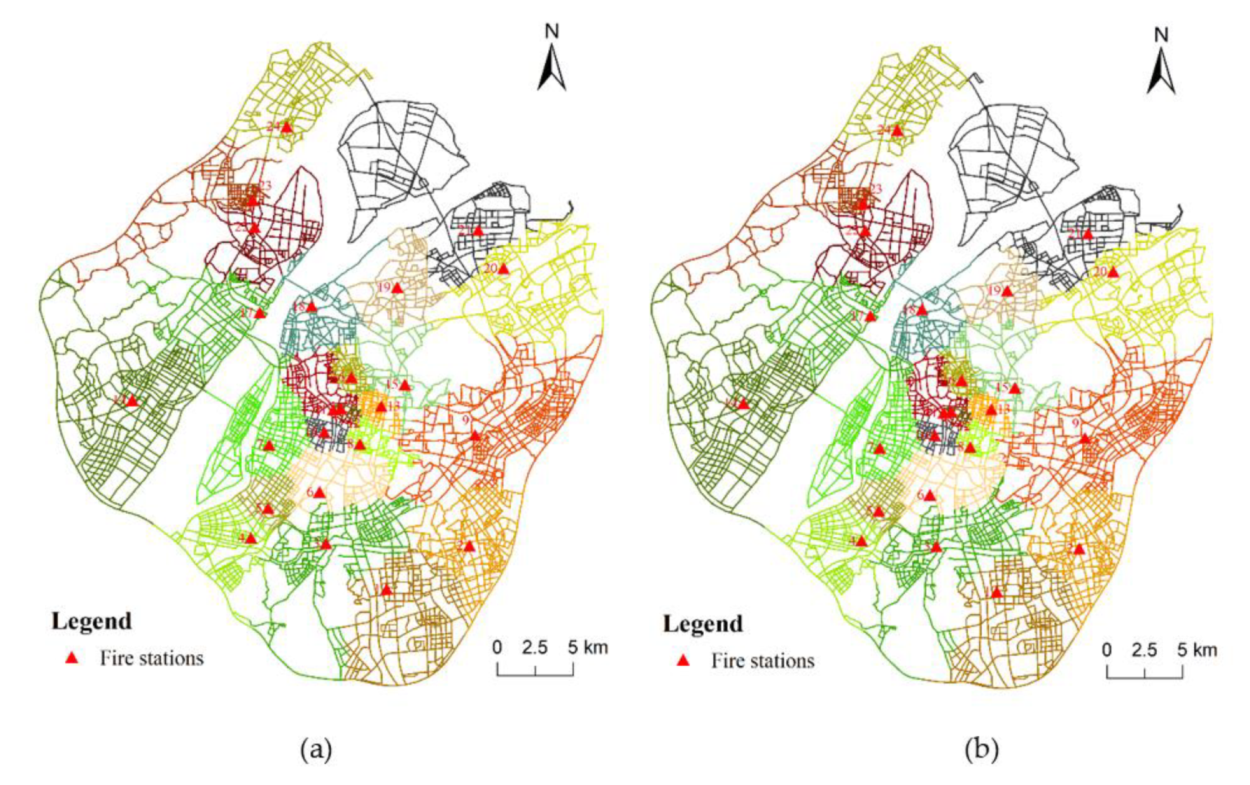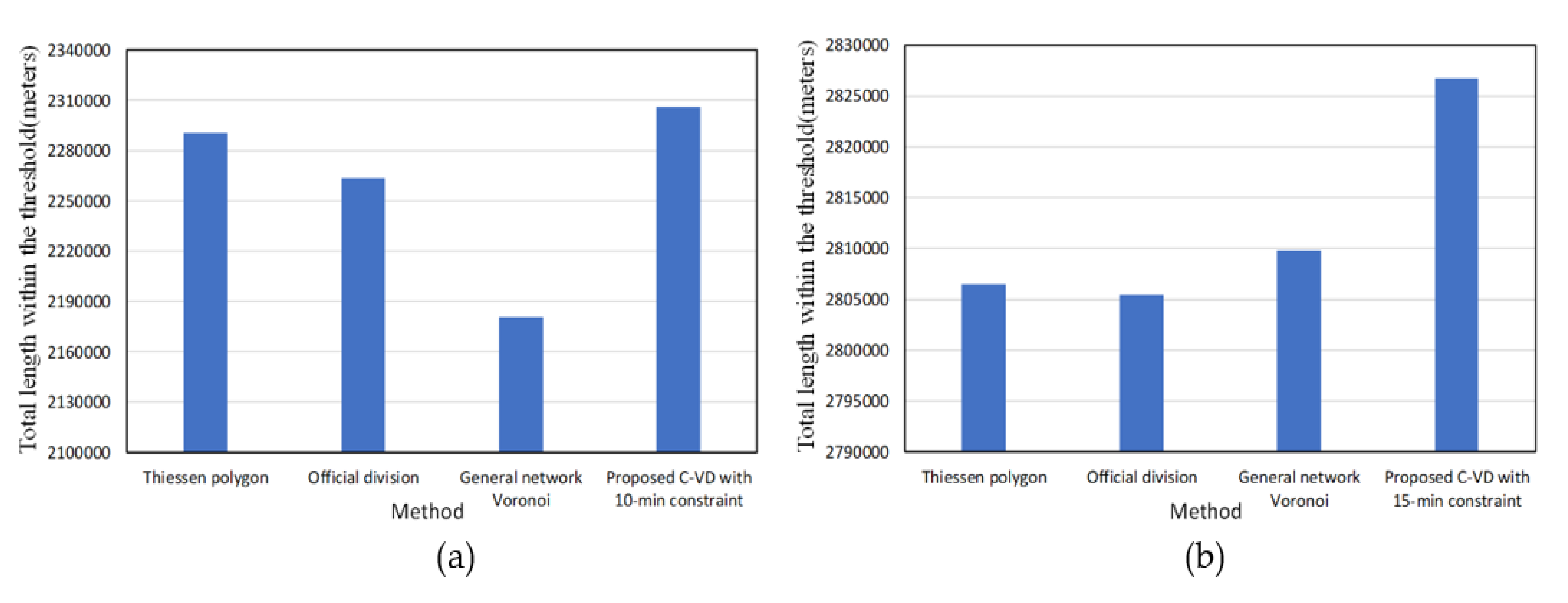1. Introduction
The demarcation of service area is one of the most important issues in spatial partitioning, as a reasonable service area delimitation always increases the efficiency of facilities service. It has been widely studied in various fields, for example, trade zones planning [
1,
2,
3,
4,
5], medical services area planning [
6,
7,
8], and police patrol areas planning [
9,
10,
11,
12]. Although many methods have been developed to deal with spatial partitioning and service area delimitation problems, it remains a challenging task when establishing a spatial proximity model independent of the coordinate geometry.
Voronoi diagrams are widely used to deal with spatial optimization and spatial partitioning problems, especially in delimiting the service area of facilities [
13,
14,
15,
16]. Recently, Qiao et al. [
17] used the Voronoi diagram to create service areas for the charging stations in Shanghai and then identified the one with the highest time cost to locate the new facility. Despite the planning of urban services being extensively studied in the past, the balancing between service demand and supply remains a challenging task in the new complex environment. In the rapid development of urbanization, the unbalanced built environment leads to the spatial heterogeneity of service demand. At the same time, the intricate roads have greatly affected the ability of urban services. Therefore, the traditional Voronoi diagram that models the urban space as a homogeneous environment is no longer suitable for delimiting the service areas of current urban facilities.
In the literature, many extensions of the Voronoi diagram have been developed to adapt to the complexity of real-world geographic scenes. For example, Okabe et al. [
18] formulate six Voronoi diagrams defined on the network, termed generalized network Voronoi diagrams, to precisely represent service areas in urban areas. The extension of the Voronoi diagram to a network space is more in line with the real characteristics of a street network service transmission and more suitable for urban activities, e.g., retail services. With considering the geographic distribution of demands and the socioeconomic context, Wang et al. [
19] apply the hexagon-based adaptive crystal growth Voronoi diagrams to delimit middle school service areas. The results indicate that, compared with the raster-based method, the hexagon grid method is more accurate in measuring continuous weighted planes. Furthermore, the weighted Voronoi diagram allows for a more detailed modeling of services by introducing the varied capabilities of a facility. It is widely used in urban planning applications including trade zone design [
20], transportation and logistics problems [
21,
22,
23], political districting [
24], substation planning [
25,
26], and school districting [
19,
27].
However, there are few studies on the service division applied to urban emergency facilities, especially fire stations. As a critical emergency facility in cities, a fire station aims at providing timely services to cover nearby fire incidents and associated events. However, the current emergency system in China delimits the service areas of fire stations based mainly on a 2D polygon, such as block units, which is hard to take into account the variation of fire risk across regions. In addition, the existing service areas of fire stations ignore the actual route of rescue vehicles, which may consume a large amount of rescue time. Therefore, a reasonable division of fire station service area should consider three aspects including rescue accessibility, balanced workload, and related legal requirements.
Under the context of fire rescue, fire engines reach the locations of incidents through the route of a street network, and in practical applications, the main attention of planners is also paid to the division of network segments for understanding the accessibility of fire emergency service. Hence, it may be more appropriate to define the service areas of fire stations using the constraint of the street network. Besides rescue accessibility, the constraint of balanced workload should also be considered in the region partitioning method. According to the studies in resource allocation [
28], the unbalanced workload could lead to some areas becoming overstaffed while others become understaffed. It is believed that the unbalanced workload can even lead to morale problems and span-of-control issues. In this paper, we quantify the workload by the density of events. Kernel density estimation (KDE) is a popular method in analyzing the first-order properties of point event distributions [
29,
30,
31]. KDE generates smooth density surfaces of point events in space by calculating the intensity of events as density estimation. With much attention paid to the network analysis, network kernel density estimation was also used in analyzing urban point events, e.g., traffic accidents [
32].
Furthermore, according to the regulations of the Ministry of Public Security, an important principle of fire station planning is that fire engines can reach the locations of fire events in 5 min [
33]. Such Golden 5 min constraint can ensure that the fire damage is efficiently controlled by the fire fighters before residents suffer a great loss in the fire. However, the constraint of workload requires assigning a place to a fire station according to fire risk, and there is a need to improve the Voronoi model by increasing the cumulative coverage area of 5 min of all the Voronoi generators.
With the abovementioned three issues considered, we propose a constrained Voronoi diagram (C-VD) to detect the service area for emergency facilities (e.g., fire station). In general, our method is more effective than the traditional method by introducing three constraints including street network constraint, fire risk constraint, and Golden 5 min fire rescuing constraint. More specifically, considering that the interaction between demand and supply of fire service is along the street network, we adopt the network shortest-path distance in proximity analysis and obtain the service area of fire stations as the network section consisting of segments and nodes. In addition, since the fire risk varies across locations of urban space, the regions with the same area may have different workloads in the emergency service system, and thus, we propose to weigh the network distance by quantifying the workload of locations on the street network. This process is realized by adding the data of historical fire incidents. Furthermore, in order to increase the cumulative 5-min coverage area of fire stations, we propose a new algorithm for generating a C-VD. Specifically, all the generators of the fire station expand along the street network simultaneously, and when an operator reaches the boundaries of the 5-min neighborhood, it stops until all the other operators meet the time threshold of 5 min. Our algorithm introduces the fire risk into distance calculating, and at the same time, it takes into account the specific requirement of fire rescuing, i.e., increasing the cumulative coverage area of 5 min of fire stations. In this way, the space tessellation of a C-VD can be very different from the result of the general Voronoi diagram.
The paper is organized as follows:
Section 2 details the methodology of C-VD.
Section 3 describes the study area and data.
Section 4 analyzes and discusses the experimental results.
Section 5 concludes the research and provides future directions.
2. Methodology
Although our proposed C-VD is still based on the principle of assigning a place to the nearest generator, it introduces three additional constraints (i.e., street network constraint, fire risk constraint, and Golden 5 min constraint) to obtain a more practical result of the service area division for fire emergency facilities. To incorporate all the constraints, we first project fire stations to the nearest locations on the street network and define their service area as a set of network segments and nodes (
Section 2.1). In this way, the fire station provides emergency service along the network distance rather than Euclidean distance. Second, the fire risk on network segments is quantified by using the kernel density analysis of historical fire incidents, and then, the network distance is weighted by such a variable to calculate the workload on each network segment (
Section 2.2). Finally, an extended network expanding algorithm is used to help increase the 5-min coverage areas of C-VD of the fire stations (
Section 2.3).
2.1. Constraint of Street Network
In order to model the constraint of network distance, we use a graph structure to represent the street network. Specifically, a street network is formalized as where is the set of nodes and is the set of edges in the street network. For simplicity of concept demonstration, we assume the graph is planar and non-directed.
In addition, the expanding operation of generator points in the C-VD is carried out along the street network, and thus, the next step is to project the generator points
onto their corresponding nearest locations on the street network. This process can be realized by calculating the Euclidean distance between generator points (i.e., locations of fire stations) and network segments. At the end of this stage, the projected points on the network are detected as the proxy of fire stations for further analysis.
Figure 1 presents a comparison between the traditional Voronoi diagram and our division method with adding street network restriction.
2.2. Constraint of Fire Risk
In addition to the geometric distance, fire risk is another important factor that constrains the service area of a fire station by representing the demand in urban space. In general, the more likely the fire events could occur, the larger workload the neighboring fire stations have. Hence, it is critical to quantify the distribution of fire risk across the space. Actually, there are many factors contributing to fire risk, e.g., population age, building age, building density, land use, etc. The result of fire risk variation can be directly reflected by the density patterns of historical fire event points. The more fire incidents a local region has, the higher fire risk it has and, then, the larger the workload covered for it should be. In addition, fire risk should be distributed around the location of the fire incident. More specifically, the actual location where a fire incident occurs has the largest risk, and with the increase of distance from the incident location, the neighboring locations have a decreased risk. This conforms to the requirement of a “distance decay effect”, which is a specific form of the First Law of Geography in spatial analysis research. Taking into account these factors, we adopt the kernel density method to calculate the fire risk in space.
The kernel density estimation (KDE) method uses a kernel function to model the “distance decay effect”, in which the point density value decreases gradually with increasing distance from the focus. Many studies have proved that the network kernel density estimation (N-KDE) is more suitable for analyzing hot spots occurred inside the network space than traditional planar KDE [
32]. They suggest that the planar KDE (
Figure 2a) could possibly over-detect clustering patterns [
32].
Therefore, we propose to use the N-KDE to calculate the spatial density values of fire incidents on the street network (
Figure 2b). In order to obtain the kernel density distribution of the entire road network, we need to split all the links in the network by a predefined segment size. The link segmentation has been a common practice for network-based analyses that need to capture the distribution of events across street network [
30,
31,
32,
34]. Therefore, we firstly divide each street segment into basic linear units of a predefined network length, and then, for a point
on the network, its kernel density value
is given by the following:
where
is the total number of event points within the range of network distance threshold
,
is the search bandwidth,
is the projection point of event located in the catchment of
,
is the network distance between point
and point
, and
is the kernel function that models the “distance decay effect” of the density. In the literature, there are many forms of the kernel function such as the Gaussian, Quartic, and Conic. Although these functions weigh the density values in different forms, they are all based on the same process that the weight value decays from the center to the surrounding locations according to distance. In addition, it has been widely accepted that the choice of function is less important than the choice of an appropriate search bandwidth (i.e., catchment size) [
31,
32]. Therefore, this paper chooses a quadratic function (Equation (2)), which is one of the most commonly used functions in spatial analysis.
It should be noted that there is no standard method to determine the bandwidth and the threshold should be adjusted according to the application context [
31]. In general, a large bandwidth emphasizes the global pattern of point distribution while a small bandwidth can help detect the detailed variations of point pattern. Our research determines the bandwidth according to the specific context of fire emergency service (please see
Section 4.1).
In order to integrate the two indicators (i.e., geometric distance and fire risk) into the cost (
) of a street segment, we use the weighting method as follows.
where
and
respectively represent the geometric length and the fire risk of each segment in the street network and where
is a factor that determines the weight of the geometric length in integration. In the practical applications, the parameter
represents the degree to which users attach importance to the constraint of geometric distance. Some applications emphasize the influence of distance on workload, while others may turn to the fire risk. In general, the contribution of the indicators should be determined under the specific application context, and in our research, we would evaluate the behavior of a C-VD with the change of the weight
a (please see
Section 4.1). An example is presented in
Figure 3, where the VDs with considering fire risk and without considering fire risk are compared. It can be found that, after adding the fire risk constraint, the fire stations having frequent fire accidents in their neighborhoods have a reduced service area, and that means the workloads are balanced via reducing the geometric coverage in our model (
Figure 3).
2.3. Implementation
The procedure of generating a network-constrained Voronoi diagram is based on the network expansion operation, which starts from the locations of the generator points and expands outwards along the network gradually and synchronously. During this process, the node that has the minimum cost in the current iteration will be assigned to the service area of the corresponding generator. It should be noted that the general operation of network expansion does not take into account the specific requirement of fire rescuing (i.e., Golden 5 min constraint): that is, the fire engine should reach the location of the fire incident within 5 minutes. Hence, we propose a new algorithm to increase the 5-min coverage area of the general Voronoi diagram. According to the official report by the Fire Department of Ministry of Public Security, the average speed of urban fire truck is about 30–35 km/h. In addition, we analyzed the GPS track data of fire trucks in Nanjing and found that the average speed of fire trucks was 32 km/h. Therefore, the time threshold of 5 min in our method can be converted into the geometric distance of about 2667 m.
Based on the context mentioned above, the following steps are implemented to generate the proposed C-VD with the Golden 5 min constraint (
Figure 4).
- (1)
Construct the graph structure of the street network by modeling the street segments and the street intersections as edges and nodes, respectively. Based on this graph, each point of a fire station is projected to its nearest location on the street network according to the Euclidean distance.
- (2)
Densify the street network by adding equidistant points on the street segments, and calculate the network kernel density values of the fire incident points on these sampled locations according to Equations (1) and (2). Then, the geometric length and the fire risk of a street segment are integrated into the cost measure of an edge according to Equation (3).
- (3)
Expand the network from the locations of fire stations. This step generates a network-expanding operator for each fire station, and all the operators would expand along the network simultaneously; the nodes that are traversed by an operator would be assigned as the part of the service area of the corresponding fire station (
Figure 4a).
- (4)
Perform Step (3) repeatedly until one of the operators reaches the boundaries of Golden 5 min coverage.
- (5)
Stop the network-expanding operators that reach the Golden 5 min boundaries of fire stations, and continue to perform the other operators (
Figure 4b).
- (6)
Perform all of the operators synchronously when they reach the Golden 5 min boundaries (
Figure 4c).
- (7)
Generate the service area of fire station which consists of the nodes and segments traversed by the corresponding expansion operator (
Figure 4d).
Compared to the traditional algorithm, our algorithm obtains the service areas in the form of segments and nodes. The proposed algorithm not only can introduce the constraints of the street network and the fire risk into the Voronoi cost measure but also can take into account the specific application of fire rescuing that aims at increasing the coverage area of 5 min in the constructed Voronoi cells.
3. Data and Study Area
With the rapid development of the economy in the last 30 years, a large volume of rural land space of China has moved to the urban areas, thus bringing massive population in the major cities in China such as Nanjing. The urbanization process also brings about the increase of fire risk in high-density areas. In the built environment of China, for the effective use of urban space, buildings tend to be closely connected, which usually occupy fire exits [
35]. In recent years, urban fire accidents have become more and more costly and this situation has attracted great attention from urban managers. The Chinese government attaches great importance to the impact of fire accidents and has further revised the national fire control law in 2019 [
36].
Our study area is located in Nanjing, capital of the Jiangsu province. As a central city, Nanjing is one of the most important scientific research and education bases and comprehensive transportation hubs in the east of China. It has jurisdiction over 11 districts with a total area of 6587 square kilometers. Nanjing is the only megalopolis in the Yangtze river delta of east China. According to the National Bureau of Statistics of China, the average population density of Nanjing is about 1034 persons/km
2, which is 7.2 times the national average in 2017. Such a high density of population brings enormous pressure on fire risk prevention in Nanjing, which is also faced by other cities in the Jiangsu province. Hence, in recent years, Jiangsu province has promulgated the Fire Safety Index System of Jiangsu Province [
37], which is the first national fire work evaluation system in the name of a provincial government. Such policy specifies that the fire accident rate of 10,000 people should be lower than 2 and that the fire death rate should be lower than 0.019. Therefore, although Nanjing faces an increased risk of fire accident in recent years, it acts as a pioneer in the field of fire control in China.
This research selects the nine most densely populated urban districts of Nanjing as the study area, including Liuhe, Qixia, Pukou, Gulou, Xuanwu, Jianye, Qinhuai, Yuhuatai, and Jiangning (
Figure 5a). Our data is obtained from the Fire Department of the Public Security of Nanjing, which contains street network data, fire station data, and fire incident data. More specifically, there are 8636 edges/links and 6248 street intersections/nodes in our street network data. We obtain 24 fire station points and 2503 historical fire accident points from March to December 2015 (
Figure 5b).
5. Conclusions and Future Work
Emergency services are closely related to people’s lives and property in built environments. How to delimit the service areas of emergency facilities effectively is a critical component in this process. However, due to the lack of relevant event data, research of emergency facilities mainly focuses on the general computing method, and there is little research on the investigation of service area delimitation of emergency facilities by combining the actual emergency rescuing constraints. In our work, we obtained the data sets of fire stations, street network, and historical fire events in Nanjing, and with these data, a new method, the constrained Voronoi diagram (C-VD), is proposed to delimit the service areas of fire stations by considering the constraints of accessibility, fire risk, and coverage area.
The proposed C-VD provides an effective service area division of fire stations through adding three constraints to the traditional planar Voronoi diagram. First, since the movement of vehicles in urban areas depends on the alignment of street network, we propose to use the network shortest-path distance rather than Euclidean distance to analyze the neighboring relationships between locations. This is particular useful for managing emergency facilities (e.g., fire stations) because the network route is the main transport for fire engines. In this respect, we obtain the service area as a set of street segments and intersections, which can facilitate the path planning of fire rescuing on the basis of our result. Second, besides the geometric distance, the variation of fire risk across the space can also impact the service area partitioning of fire stations. In general, the higher fire risk a place has, the more fire protection resources should be allocated to this place. Under our context, this constraint would result in a fire station near high-risk locations having a relatively small service area for the effective management of fire events. Considering the distance decay effect of fire risk, our proposed method calculates the network kernel density values of historical fire event points to quantify the fire risk along street network. Hence, the service areas delimited by our C-VD can take into account the spatial variation of demand in fire rescuing. Finally, in order to introduce the constraint of fire rescuing that fire engines should arrive at the location of fire event within 5 min, the proposed C-VD extends the traditional network expansion operation by increasing the 5-min coverage areas in a Voronoi tessellation. Since fire risk changes across time and space, our method can generate dynamic service area division with the addition of fire events data in different time periods. Such dynamic result may be very valuable for the applications that need to allocate rescuing resources according to time. Actually, the occurrence of fire events in urban areas has a significant characteristic of “time dependence” (please see
Figure 9).
In addition to the abovementioned issues, there are more constraints to consider in the service area division of fire services. For example, although we have considered the network distance in the spatial analysis, the constraints of traffic congestion, multiple lanes, and road direction are not added [
38,
39]. In the future, we plan to obtain the actual trajectory data of fire engines to estimate the travel time on different routes. Besides, with more semantic properties of fire stations (e.g., number of firefighters and number of fire engines), we can improve the effectiveness of our result further. In this way, the relationship between supply and demand can be better modeled in our proposed C-VD with the Golden 5 min constraint.
